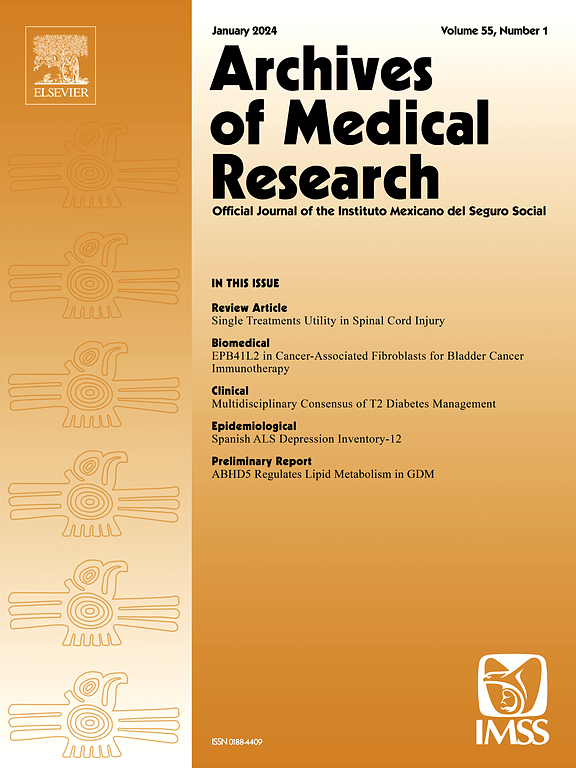Galectins: A New Frontier in Gastroesophageal Reflux Disease Research
IF 3.4
3区 医学
Q1 MEDICINE, RESEARCH & EXPERIMENTAL
引用次数: 0
Abstract
Background
Gastroesophageal reflux disease (GERD) is a common chronic condition characterized by abnormal reflux and regurgitation of stomach contents into the esophagus. Its prevalence is increasing worldwide and poses a high economic burden.
Aim
To explore the potential correlation between galectin-1, galectin-3, galectin-8, galectin-9, and GERD, highlighting their potential role as biomarkers in disease diagnosis, and pathogenesis.
Materials and Methods
A prospective cross-sectional study was conducted on 40 patients with GERD disease and 40 healthy control subjects from January 2023–May 2024 at Al-Kindy Teaching Hospital-Gastroenterology Unit. Venous blood was collected from patients and controls. Serums of both groups were quantified for galectin-1, galectin-3, galectin-8, and galectin-9 using a human ELISA kit.
Results
Galectin-1 showed no statistically significant difference in the median levels between patients with GERD and controls (p = 0.567). A significant difference was found in the median levels of galectin-3, with higher levels in patients with GERD compared to controls (p = 0.0037). The most significant was galectin-3, AUC = 0.684 (95% CI: 0.570–0.784), p = 0.003, had a significant moderate discriminatory ability in differentiating between patients with GERD and healthy controls with cutoff value <13.682, sensitivity = 74.4%, specificity = 55%, and accuracy = 61.7%.
Conclusions
This study suggests that serum galectin-3 is the best potential noninvasive diagnostic biomarker for the prediction and identification of GERD.
乳凝素:胃食管反流病研究的新前沿
胃食管反流病(GERD)是一种常见的慢性疾病,其特征是胃内容物异常反流和反流进入食管。它在世界范围内日益流行,并造成了沉重的经济负担。目的探讨半乳糖凝集素-1、半乳糖凝集素-3、半乳糖凝集素-8、半乳糖凝集素-9与胃食管反流(GERD)之间的潜在相关性,强调其作为生物标志物在疾病诊断和发病机制中的潜在作用。材料与方法对2001 - 01 / 2024 - 05 Al-Kindy教学医院消化内科的40例GERD患者和40例健康对照者进行前瞻性横断面研究。采集患者和对照组静脉血。使用人ELISA试剂盒对两组血清中半乳糖凝集素-1、半乳糖凝集素-3、半乳糖凝集素-8和半乳糖凝集素-9进行定量分析。结果galectin -1在GERD组与对照组中位水平差异无统计学意义(p = 0.567)。发现半乳糖凝集素-3的中位水平有显著差异,与对照组相比,胃食管反流患者的半乳糖凝集素-3水平更高(p = 0.0037)。最显著的是半乳糖凝集素-3,AUC = 0.684 (95% CI: 0.570 ~ 0.784), p = 0.003,对GERD患者与健康对照具有显著的中等区分能力,临界值为13.682,敏感性= 74.4%,特异性= 55%,准确性= 61.7%。结论血清半乳糖凝集素-3是预测和鉴别胃食管反流的最佳无创生物标志物。
本文章由计算机程序翻译,如有差异,请以英文原文为准。
求助全文
约1分钟内获得全文
求助全文
来源期刊

Archives of Medical Research
医学-医学:研究与实验
CiteScore
12.50
自引率
0.00%
发文量
84
审稿时长
28 days
期刊介绍:
Archives of Medical Research serves as a platform for publishing original peer-reviewed medical research, aiming to bridge gaps created by medical specialization. The journal covers three main categories - biomedical, clinical, and epidemiological contributions, along with review articles and preliminary communications. With an international scope, it presents the study of diseases from diverse perspectives, offering the medical community original investigations ranging from molecular biology to clinical epidemiology in a single publication.
 求助内容:
求助内容: 应助结果提醒方式:
应助结果提醒方式:


